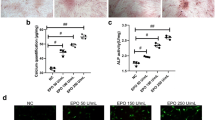Summary
To investigate the influence of osteopontin (OPN) short hairpin RNA (shRNA) on the proliferation and activity of rat vascular smooth muscle cells (VSMCs), the expressing vector of shRNA targeting OPN was constructed and transferred into the rat VSMCs. After amplification and purification, pGenesil-1/OPNshRNA1 (PG1), pGenesil-1/OPNshRNA2 (PG2) and pGenesil-1/OPNshRNAHK (PGH) were transfected into the cultured rat VSMC by Lipofectamine™ 2000. Transfected cells were visualized by using an inverted fluorescent microscope. VSMCs transfected by optimal recombined plasmid was selected by culturing in G418 48 h later. Nude cells and cells transfected by PGH were used as control. The expression levels of OPN mRNA and protein were assayed by RT-PCR and Western blotting. The OPN of VSMCs was suppressed by transfection of optimal recombined plasmid, and the changes in cell proliferation, adhesion and motility were evaluated by MTT, adhesion test and transwell chamber test. Levels of type I and III collagen were measured with ELISA kit. Our results showed that VSMCs stably transfected by OPN shRNA accounted for over 50% of total cells. OPN mRNA and protein were reduced by 81% and 67% (P<0.01) by PG1, 73% and 52% (P<0.01) by PG2, respectively while no change was found in PGH and non-treated VSMCs. PG1 significantly suppressed the proliferation, adhesion, mobility of VSMCs and reduced the amount of type I and III collagen. It is concluded that recombinant plasmid can be successfully transfected into VSMCs by Lipofectamine™ 2000 and inhibit the expression of OPN. The proliferation, adhesion and mobility of VSMCs can be inhibited by knocking down OPN expression. Moreover, the transferring capability of cells is attenuated, and the secretion of type I and III collagen is inhibited aftter knocking-down of OPN expression. The study provides experimental evidence for clinical prevention of restenosis after percutaneous coronary intervention (PCI) by RNA interference (RNAi) technology.
Similar content being viewed by others
References
Rossi JJ. Expression strategies for short hairpin RNA interference triggers. Hum Gene Ther, 2008,19(4):313–317
Xiang S, Fruehauf J, Li CJ. Short hairpin RNA-expressing bacteria elicit RNA interference in mammal. Nat Biotechnol, 2006,24(6):697–702
Okamura K, Chung WJ, Ruby JG, et al. The Drosophila hairpin RNA pathway generates endogenous short interfering RNAs. Nature, 2008,453(7196):803–806
Camenzind E, Steg PG, Wijns W. Stent thrombosis late after implantation of first-generation drug-eluting stents: a cause for concern. Circulation, 2007,115(11):1440–1455
Rodriguez AE, Maree AO, Mieres J, et al. Late loss of early benefit from drug-eluting stents when compared with bare-metal stents and coronary artery bypass surgery: 3 years follow-up of the ERACI III registry. Eur Heart J, 2007,28(17):2118–2125
Speer MY, Chien YC, Quan M, et al. Smooth muscle cells deficient in osteopontin have enhanced susceptibility to calcification in vitro. Cardiovasc Res, 2005,66(2): 324–333
Nakazawa G, Finn AV, Joner M, et al. Delayed arterial healing and increased late stent thrombosis at culprit sites after drug-eluting stent placement for acute myocardial infarction patients: an autopsy study. Circulation, 2008, 118(11):1138–1145
Okamoto H. Osteopontin and cardiovascular system. Mol Cell Biochem, 2007,300(1–2):1–7
Kim D, Rossi J. RNAi mechanisms and applications. Biotechniques, 2008,44(5):613–616
Fire A, Xu S, Montgomery MK, et al. Potent and specific genetic interference by double-stranded RNA in Caenorhabditis elegans. Nature, 1998,391(6669):806–811
Elbsdhir SM, Harborth J, Weber K, et al. Analysis of gene function in somatic mammalian cells using small interfering RNA. Methods, 2002,26(2):199–213
Scherr M, Eder M. Gene silencing by small regulatory RNAs in mammalian cells. Cell Cycle, 2007,6(4): 444–449
Gantier MP, Williams BR. The response of mammalian cells to double-stranded RNA. Cytokine Growth Factor Rev, 2007,18(5–6):363–371
Paddison PJ, Silva JM, Conklin DS, et al. A resource for large-scale RNA-interference-based screens in mammals. Nature, 2004,428(6981):427–431
Bems K, Hijmans EM, Mullenders J, et al. A large-scale RNAi screen in human cells identifies new components of the pathway. Nature, 2004,428(6981):431–437
Elbashir SM, Harborth J, Lendeckel W, et al. Duplexes of 21-nucleotide RNAs mediate RNA interference in cultured mammalian cells. Nature, 2001,411(6836):494–498
Song J, Giang A, Lu Y, et al. Multiple shRNA expressing vector enhances efficiency of gene silencing. BMB Rep, 2008,41(5):358–362
Giflin L, Karelsky S, Andino R. Short interfering RNA confers intracellular antiviral immunity in human cells. Nature, 2002,418(6896):430–434
McCafrey AP, Meuse L, Pham TR, et al. RNA interference in adult mice. Nature, 2002,418(6893):38–39
Haasnoot J, Westerhout EM, Berkhout B. RNA interference against viruses: strike and counterstrike. Nat Biotechnol, 2007,25(12):1435–1443
Chang H. RNAi-mediated knockdown of target genes: a promising strategy for pancreatic cancer research. Cancer Gene Ther, 2007,14(8):677–685
Author information
Authors and Affiliations
Additional information
The two authors contributed equally to the project.
This project was supported by a grant from the Science and Technology Foundation of Hubei Province (No. 2006AA-301C18).
Rights and permissions
About this article
Cite this article
Ye, S., Sun, Y., Bie, A. et al. Influence of osteopontin short hairpin RNA on the proliferation and activity of rat vascular smooth muscle cells. J. Huazhong Univ. Sci. Technol. [Med. Sci.] 29, 144–149 (2009). https://doi.org/10.1007/s11596-009-0202-5
Received:
Published:
Issue Date:
DOI: https://doi.org/10.1007/s11596-009-0202-5




